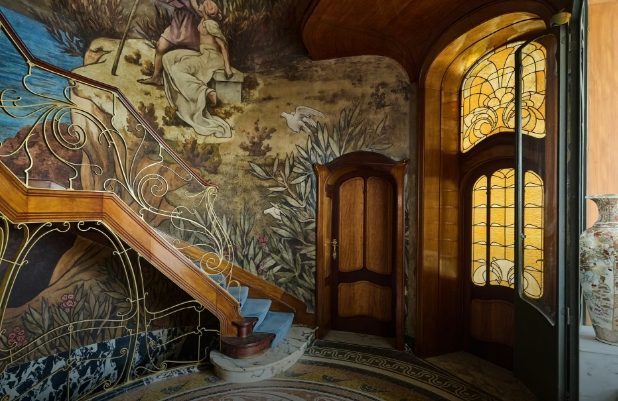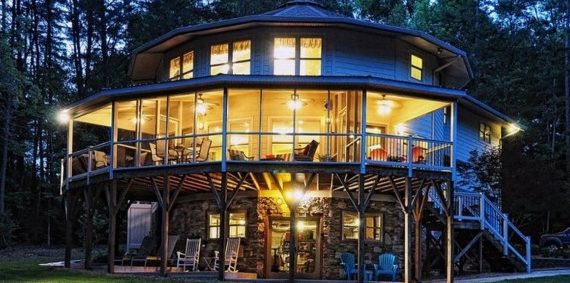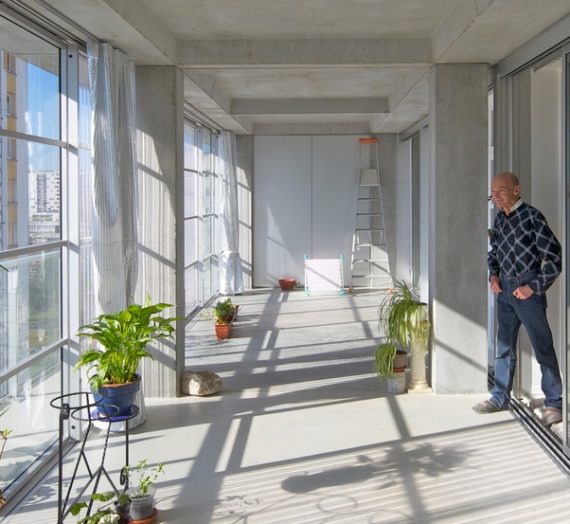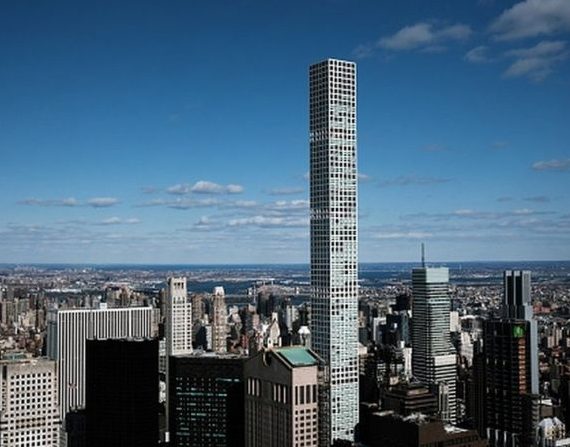Exploring Art Nouveau’s Aesthetic Movement in the Events
The legendary Maison Hannon, situated in the vibrant district of Saint-Gilles in Brussels, is frequently hailed as a captivating marvel. Gazing upon its luminous white-brick and limestone exterior, one cannot help but feel a sense of otherworldliness that envelops the building.
The gracefully arched windows of Maison Hannon are adorned with intricate floral stained-glass designs, adding an air of elegance. The surrounding ironwork, painted in a captivating golden hue, exhibits sweeping and sinuous patterns. A sculpted stone panel graces the facade, depicting a female figure dressed in a flowing gown, holding a spindle. As one steps inside, the intrigue deepens with the presence of expansive Symbolist frescoes and mesmerizing mosaic floors that swirl with intricate patterns.
Conceived in 1902, Maison Hannon was the remarkable brainchild of the French-Belgian duo, Marie and Édouard Hannon. Their vision was masterfully realized by their relatively lesser-known Belgian architect friend, Jules Brunfaut. Throughout its existence, the house has experienced both grandeur as a remarkable Art Nouveau statement and periods of neglect, rendering it a derelict structure. However, on June 1, the building was revitalized and reopened its doors as a museum, allowing visitors to once again appreciate its unique charm.
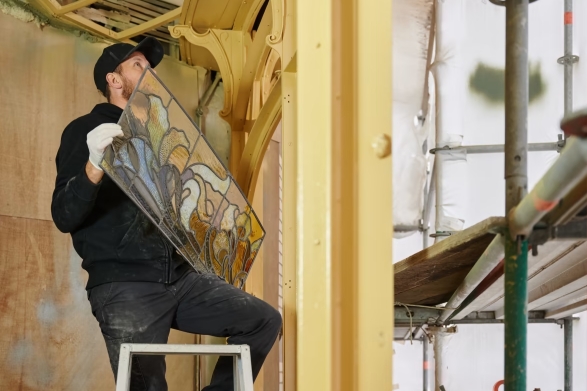
“In this neighborhood, it marks a renaissance,” remarks Jean Spinette, the mayor of Saint-Gilles, while emphasizing the overwhelmingly positive response from the local community towards the restoration project. The endeavor, which received partial funding from the Region of Brussels and the Commune of Saint-Gilles, presents a splendid opportunity to showcase the magnificent Art Nouveau architectural gems that grace the streets of Saint-Gilles. Spinette adds:
“It’s a tremendous opportunity for us to highlight the stunning Art Nouveau buildings that Saint-Gilles proudly houses.”
The inauguration of Maison Hannon marks a significant moment within the citywide festival, Art Nouveau Brussels 2023. This year-long program features a diverse array of events, including captivating exhibitions and enlightening guided tours. Particularly, June 10, recognized as World Art Nouveau Day, promises an abundance of engaging activities and festivities.
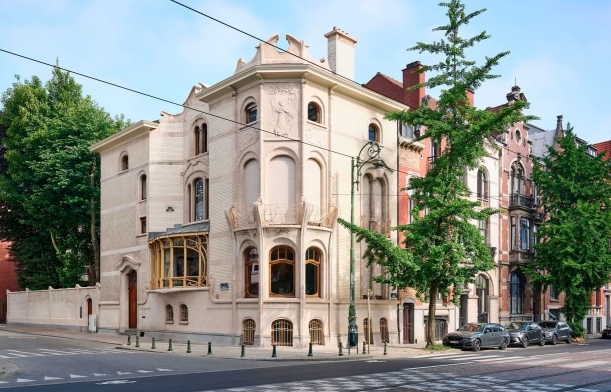
According to Pascal Smet, the State Secretary of the Brussels-Capital Region, who oversees urbanism and heritage, the core of the campaign is centered around opening the city’s Art Nouveau buildings to the public. Smet highlights notable landmarks such as the Hannon House and the former residence and studio of Belgian architect Victor Horta in Saint-Gilles as prime examples of the city’s most emblematic structures. Additionally, renowned sites like Hôtel van Eetvelde, Hôtel Solvay (both also designed by Horta), and Maison Cauchie, with its captivating illustrated facade inspired by the work of Charles Rennie Mackintosh, contribute to Brussels’ claim as the “Capital of Art Nouveau”. Banners adorning lampposts throughout the city proudly display this title.
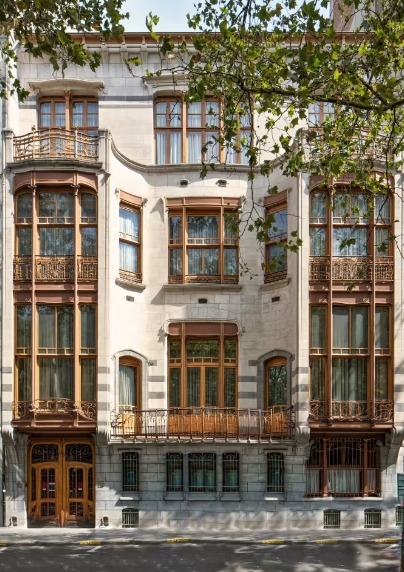
The artistic movement that thrived in the late 19th century throughout Western Europe is often visually epitomized by the iconic, sinuous metro stations of Paris (crafted by French architect Hector Guimard) or the enchanting, graceful women portrayed in the works of Czech artist Alphonse Mucha. However, it is widely acknowledged that the first exemplar of Art Nouveau architecture emerged in the Belgian capital. Hôtel Tassel, a private townhouse designed by Horta and completed in 1893, stands as a pioneering masterpiece, combining an innovative emphasis on light-infused spaces with intricate, organic forms. The city’s year-long festival commemorates the 130th anniversary of the building’s remarkable completion, paying homage to its significance in the Art Nouveau movement.
Smet emphasizes that when the general public hears the term “Art Nouveau,” they are more likely to associate it with Barcelona and Gaudí rather than Brussels. However, Smet proudly asserts that Brussels is indeed the true capital of Art Nouveau. This year marks the beginning of reclaiming this title and firmly establishing it as an integral part of Brussels’ identity.
Initially tasked with creating a museum of decorative arts, conservator Grégory Van Aelbrouck’s role at Maison Hannon took an interesting turn. The comprehensive archive he encountered, which included historical invoices documenting every detail of the construction process, as well as a treasure trove of letters and photographs by Hannon, convinced him to take on the restoration as well. Hannon’s involvement with the Belgian Association of Photography, evident from his personal darkroom in the house, added to the richness of information available. Van Aelbrouck saw this wealth of material as a means to faithfully recreate the unique universe of Édouard Hannon within the museum.
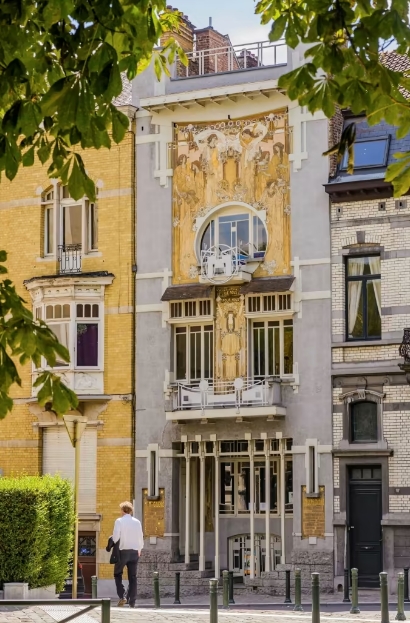
Édouard Hannon, an engineer employed by the chemical company Solvay, met his wife during his time stationed at the company’s factory near Nancy, France. Their residence in Brussels beautifully combines elements from both French and Belgian Art Nouveau styles, according to Van Aelbrouck. Notably, the house features original furniture specially commissioned from the renowned French Art Nouveau master Émile Gallé, which will be displayed once again in its original setting.
In addition, the architectural design of the house reflects Marie’s fascination with botany. A remarkable indoor greenhouse is seamlessly incorporated into the structure, with its metal and glass framework extending from the facade. The design also incorporates Édouard’s various interests, such as poetry, antiquities, and photography.
According to Van Aelbrouck, the couple envisioned their home as a “Symbolist and dreamlike universe.” This vision is brought to life through various artistic elements, including the frescoes of muses created by Paul Baudouin, a follower of Symbolist painter Puvis de Chavannes. Additionally, the sculptor Victor Rousseau contributed to the ambiance with his bas-relief stone panels.
Van Aelbrouck explains that the essence of the building revolves around the magical “golden hour” just before sunset. This concept serves as an allegory for the golden age of the couple’s lives, as they were in their fifties when they constructed this house.
The ongoing renovation of Maison Hannon is scheduled for completion in 2030. The exterior, living rooms, and stairwell have already been fully restored. On the upper floors, there is an exhibition area showcasing the works of renowned Belgian architects, including Horta, Van De Velde, Hankar, and Serrurier-Bovy.
“I aim to highlight the diversity of the Art Nouveau movement, going beyond Horta. Many other architects were even more avant-garde,” says Van Aelbrouck.
He cites La Maison Cauchie as an example, a 1905 creation by artist couple Paul and Lina Cauchie, which served as a promotional showcase for their artistic endeavors.
Not every Art Nouveau building in Brussels has been fortunate. The term “Brusselisation” emerged from a past approach to urban planning that was heavy-handed, resulting in the dismantling of Horta’s Hôtel Aubecq in 1950.
“Its facade was preserved but left neglected, “overgrown with mold and covered in trash in a Brussels warehouse,” as reported in 2016. Similarly, Horta’s Maison du Peuple, a public building commissioned by the Belgian Workers’ Party, was demolished 15 years later.”
Barbara Van der Wee, an architect based in Brussels and a conservation specialist who has been involved in the restoration of several Horta buildings, says.
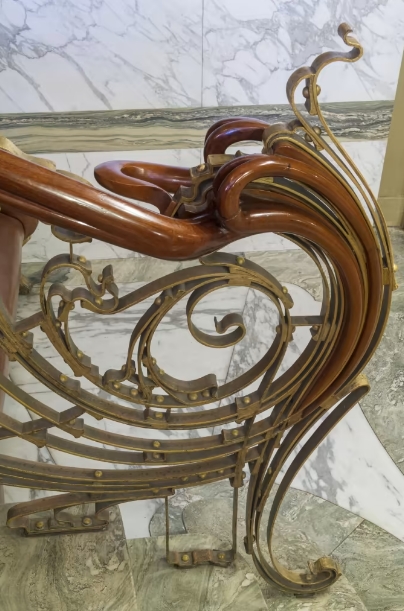
“Today, there is a greater awareness, interest, and understanding of the Art Nouveau movement. The city has made significant efforts to invite citizens to explore these buildings. Over the past two decades, important houses have been meticulously restored and are now accessible to the public.”
At present, “nine houses are regularly open to the public,” confirms Alice Graas, the coordinator of Art Nouveau Brussels 2023, with more buildings in the pipeline. Among Barbara Van der Wee’s recent projects is the restoration of the facade of Hôtel Solvay, Horta’s magnificent townhouse on the prestigious Avenue Louise, originally built for Armand Solvay, the son of Ernest Solvay, the chemist, industrialist, and founder of the Solvay group.
The house was opened to the public in 2021. One notable change on the exterior is the color of the ironwork. Using new methods to examine the original paint, the ochre brown has been transformed into a very light pink, which perfectly matches the color found throughout the interiors.
“It is truly remarkable.”
Barbara Van der Wee’s involvement with Horta’s projects extends to the Hôtel van Eetvelde, a building she began working on during her time as a student. Recently, the entire building was opened to the public for the first time, featuring a new Art Nouveau information center called LAB·An. Initially constructed for Edmond van Eetvelde, the general administrator of foreign affairs for the Congo Free State, the newly added exhibition spaces explore “the connection between Belgian Art Nouveau and the Belgian colony of the Congo.”
In 1885, Belgian King Leopold II claimed the Congo Free State as his personal possession, which later became a Belgian colony from 1908 until its independence in 1960. The discussion surrounding this dark history has gained prominence with the Black Lives Matter movement, particularly in relation to colonial monuments within the city. To address these issues, a working group was established at the end of 2020 with the aim of initiating a crucial reflection on symbols in public spaces associated with colonization and the colonial era.
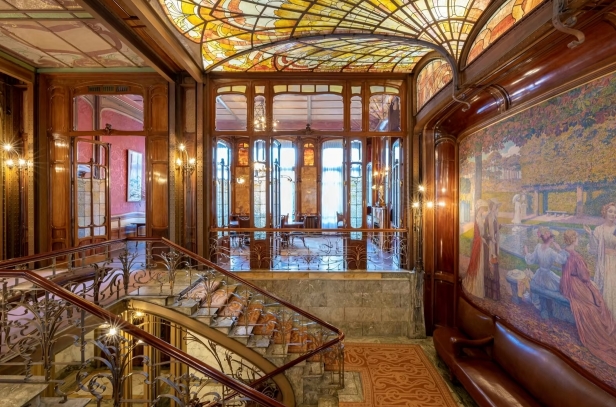
The outcome of these efforts is a comprehensive 233-page report accompanied by a 14-point action plan. The plan includes important directives such as the appointment of a decolonization coordinator and exploring the feasibility of establishing a memorial honoring the victims of colonialism. At Hôtel van Eetvelde, a special mini-exhibition is dedicated to the original owner of the house, who held a significant role as one of King Leopold II’s closest advisers. Hortense de Ghellinck, co-coordinator of LAB·An, explains that the exhibition aims to provide insights into Eetvelde’s personal life as well as his involvement in the colonization of Congo.
King Leopold II’s passive response and apparent indifference to the atrocities committed against the Congolese people have been a source of intense criticism and ongoing debate. According to Sandrine Colard, an assistant professor of African art history at Rutgers University and the editor of Recaptioning Congo: African Stories and Colonial Pictures, the emergence of new and meticulous research examining the connection between colonialism in Congo and Art Nouveau is both thrilling and transformative for Belgium, challenging long-held national perspectives.
“It does not diminish the significance of the movement and its artists,” she emphasizes. “In fact, it enhances it by enabling a more comprehensive and diverse comprehension.”
As part of the Art Nouveau Brussels 2023 program, another noteworthy event is Style Congo: Heritage & Heresy, an exhibition held at the CIVA Centre for Architecture until September 3. This exhibition combines contemporary artwork with archival materials to explore the interconnections between the Congo and Belgian Art Nouveau, which was also referred to as “Style Congo” during that era.
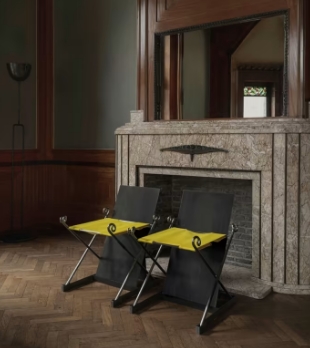
The exhibition also features new photography by Brussels-native artist Chrystel Mukeba. Her portraits capture Afro-descendant Belgians within the captivating ambiance of the city’s Art Nouveau buildings, including the Horta Museum and Hôtel Van Eetvelde.
“When you explore these houses, you can observe the influence of the Congo in the motifs, forms, and materials,” she explains. “It was crucial to highlight the presence of the Congolese community. My intention is not to provoke controversy, but rather to encourage reflection on the past.”
According to Graas, Style Congo has experienced an unprecedented surge in visitor numbers during its first six weeks. She also emphasizes that one of the festival’s overarching objectives is to explore the Art Nouveau movement from fresh perspectives. This entails recognizing the contributions of often overlooked artisans and female artists. Another concern raised by some individuals is that these beautiful houses were exclusively designed for the affluent upper class. Van Aelbrouck remarks:
“Heritage buildings created for the wealthy are often seen as opposing modernity. Frankly, the primary question we receive from visitors is, ‘What measures are being taken for energy and the environment?’ We are striving to strike a balance between preserving our heritage and embracing ecological transition.”
To achieve this objective, the restoration of Maison Hannon is receiving assistance from Vinci Energies Belgium, both in terms of its refurbishment and sustainability efforts. This matter is particularly significant to Van Aelbrouck, who is currently renovating his own Art Nouveau residence. Van der Wee asserts that the primary challenge in preservation today is to address contemporary energy efficiency requirements while simultaneously safeguarding the integrity of the building. One of her ongoing projects exemplifies how an Art Nouveau structure can be given a fresh purpose and modern significance.
The historically significant Hôtel Danckaert, originally created by Belgian architect Jean-Baptiste Dewin in 1922, showcases an Art Deco aesthetic rather than Art Nouveau. However, it has now been repurposed as the residence for the contemporary Brussels design gallery known as Maniera.
“As of now, we are presenting the house in its original state,” explains Amaryllis Jacobs, co-founder of Maniera, referring to the villa initially constructed for industrial engineer Jean Danckaert in the Forest district of Brussels. “However, we are preparing to commence the restoration process, including updating the electrical system and installing a new roof… Historians have recently uncovered exquisite floral wallpapers that were once part of the house’s interior.”
However, there are many who argue, “Don’t touch it, it’s beautiful as it is.” The interior furnishings and decorations from the early 20th century, crafted by Belgium’s Ateliers d’Art De Coene, now coexist with striking artistic rugs by Christoph Hefti and the substantial furniture pieces created by the Georgian design duo Rooms Studio.
Jacobs affirms, as she describes their approach. She further mentions that they have transformed the top floor into an apartment that is now available on Airbnb:
“We take delight in demonstrating how contemporary works breathe new life into these interiors. There was a great deal of curiosity surrounding the house, and we wanted it to be accessible to the public. If someone wishes to come and enjoy a picnic in the rose garden, we welcome them with open arms.”

